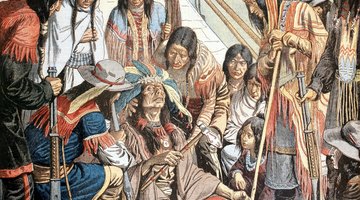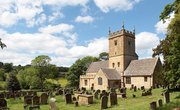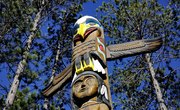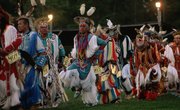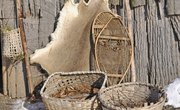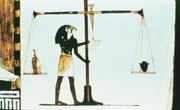Burial traditions of the Choctaw Nation in Oklahoma are some of the best-documented Native American rituals by Europeans and early Americans. The Choctaw allowed the body of the deceased to decompose naturally on an outdoor platform set away from the home. Prior to the 19th Century, the Choctaw also practiced a unique type of double burial, where the bones of the deceased left over after decomposition were buried much later in a village-wide festival.
Sun Ritual
The sun played an important role in Choctaw burial rituals. When a member of the tribe died, the body was placed on a platform or bier in a nearby forest and allowed to decompose naturally. The body was left outside in the elements for a year or more, during which time the Choctaw believed the spirit of the deceased was returning to the supreme power of the sun, which held "the ultimate power of life and death," according to the Encyclopedia of American Indian Religious Traditions.
The Bone Picker
After sufficient decomposition, a holy Choctaw man called the "bone picker" visited the body to scrape the bones clean with his fingernails. The bone picker returned the bones to the village, where the remains were painted with ocher dye and stored in a communal bone house with the bones of other Choctaw deceased. Periodically, the bones of the deceased were brought out among the living for tribal occasions like games and community gatherings.
Double Burial
Eventually the communal bone houses of the Choctaw would fill up with remains, and then the bones were removed and buried together in an elaborate ritual. To bury the bones, Choctaw tribal members from miles around congregated for a major burial ceremony wherein remains were interred under a mound of earth and stones, according to Choctaw historian Clara Sue Kidwell . The burial was followed by a village-wide cry of cathartic mourning and a large feast in honor of the dead.
Changes in Burial Rituals
By the 19th Century, Choctaw burial practices had shifted drastically, with most tribal members opting to bury the dead in a seated position directly in the ground. Other Choctaw burial traditions began fading away -- the once widespread practice of slaughtering horses that belonged to the dead also ceased in the mid-1800's as the Choctaw came to rely on horses for their livelihood and transportation.
Related Articles
References
Writer Bio
Taylor Echolls is an award-winning writer whose expertise includes health, environmental and LGBT journalism. He has written for the "Valley Citizen" newspaper, where his work won first- and second-place awards in sports and outdoor features from the Idaho Press Club. Echolls holds a B.A. from Mount Holyoke College.

